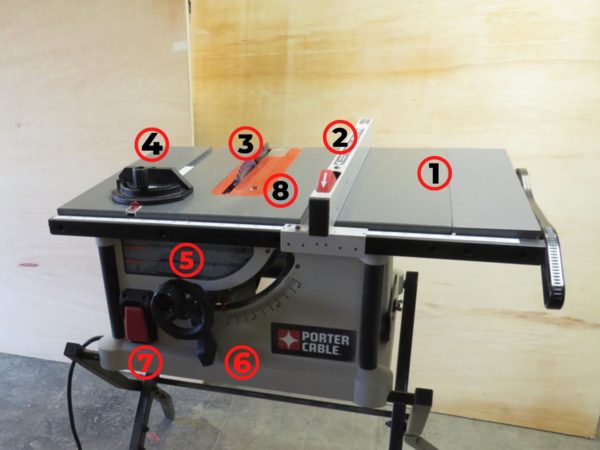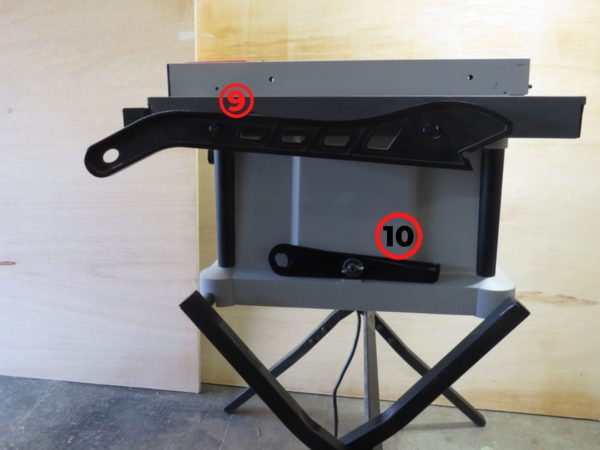Being able to use the table saw correctly can make woodworking more fun and productive. This tool can be one of the most dangerous tools in the woodshop if not used right. The good news is there are a few things that if done right can ensure your safety while working with a table saw. Now let’s take a closer look at what you need to know about using a table saw safely.
The table saw is possibly the most used woodworking power tool. This article is meant to serve those of us who already own a table saw. If you are looking to buy one, go to this article on The Best Table Saws For Beginners.
These power tools have a lot of versatility, and can quickly make a lot of different types of cuts. This article is going to cover the five easy steps to using the table saw. But stick around to the end where we answer some of the most frequently asked questions that you wonder about table saws. But for starters let’s quickly go over the main parts of a table saw.
Parts Of A Table Saw
When broken down, the parts of a table saw make up a pretty simple tool. In its simplest form it is a flat platform (table) surface with a circular saw blade sticking up out of it. But there are a few more parts to the table saw to consider. Lets go over what the other important parts there are on a table saw.

- The Table Surface- This is what the material you are cutting is sliding against. It’s important to keep the lumber flat on the surface. If it lifts off very far you might not be cutting through completely. And any time it comes off one of the two surfaces you run the risk of messing up your cut.
- The Fence- The fence is a flat surface you will be pushing the lumber against. The distance it is from the blade is adjustable. This will determine what size the piece will become once you cut it. The red part of the fence with the downward facing arrow is the “fence dog.” Push it in after you have the fence in the position you want it at to lock it in place.
- Blade- The blade on a table saw is a circular saw blade. They are predominantly either 8 inches or 10 inches, depending on the model saw you have. There are different types of blades available for the different types of cuts a table saw can make. The most common are rip cuts, cross cuts, and dado cuts.
- Miter Gauge- This is an attachment that is used to make angled (mitered) cuts with a table saw. It slides in a track that runs parallel to the blade. This is not necessary when using the fence. The miter gauge is useful for cutting the ends of smaller strips of wood.
- Blade Height Adjustment Knob- When turned, the blade adjustment knob will raise or lower the height of the blade. This is useful when cutting materials of different thicknesses. It also is useful if you are not cutting completely through the material, like when cutting a dado groove.
- Blade Angle Adjustment- This lever allows the blade to be angled, or to cut at 90 degrees. In some models it is a wheel, but in this model table saw it is a locking lever.
- On-Off Switch- Pull the on-off switch up to turn the saw on. Push it in to turn it off. This functions as a safety feature that allows the saw to be turned off with your knee.
- Blade Insert- This is a removable insert on the surface of the table. Take it off to change your blade. If you want to stack blades for making a dado cut you will want to purchase another insert that has a wider opening. Do not run a table saw without a blade insert in place.
- Push Stick- Used to push thin strips of lumber past the blade. This accessory is meant to keep your hands away from the blade when working with smaller pieces.
- Blade Change Wrenches- These wrenches are the correct size to remove the blade and put a new one back on. This is very convenient when you need to change a blade and the correct size wrench(s) are attached to the saw.

How does a table saw work
The table saw is a very important tool for woodworkers. In order to know how to use a table saw, you must first know how the table saw works. It’s important to learn the mechanics so you can safely work around the machine.
The table saw is a large, stationary circular saw. The blade is adjustable in two ways. The depth of cut is determined by adjusting the height the blade sticks up above the table. You also have the ability to tilt the blade, allowing for longer angled cuts. This option typically goes up to 45 degrees maximum.
When the blade is installed the teeth are facing the user. It spins towards you because if it spun away from you it would shoot the material forward. The teeth on the blade are a lot of tiny chisels. When they spin really fast each one takes off a small amount of material. This is how the saw can make a perfectly straight cut.
"This is a very powerful machine that can be dangerous to a user that doesn't know how to work safely around one."
How To Use A Table Saw Safely
Using a table saw can seem intimidating at first. This is a very powerful machine that can be dangerous to a user that doesn’t know how to work safely around one. But if all the steps are done right, users can go their entire life without being injured by a table saw.
It’s important to make sure you don’t have any loose fitted clothing that could get caught in the blade. I don’t even like wearing gloves when working with a table saw, even though it’s probably okay.
Safety Equipment
There are two pieces of safety equipment that are important. Proper eye protection will make sure you don’t get sawdust in your eyes. And hearing protection is important because the table saw is a very loud piece of equipment. Ear plugs are enough, but I recommend these WorkTunes Headphones by 3M.
Step 1: Blade Adjustments
To adjust the height of the blade, start by placing the board you will be cutting on the surface of the table. Press it up to the side of the blade, and turn the adjustment knob. Adjust the blade to be about one quarter of an inch above the top of the board. This doesn’t need to be exact.
Step 2: Fence Adjustment
"Make your measurement on the side of the blade closest to the fence."
If you are right handed it’s more comfortable to have the fence to the right of the saw blade. If you are left handed try running it with the fence to the left. Either side will be able to make the cut, so you should learn what’s most comfortable to you. The most common is to use the fence to the right of the blade.
The location of the fence will determine the dimensions of your piece after it’s cut. Unlock the fence from the table and slide it towards the size of your cut. If you don’t have a built-in ruler on your saw (or don’t trust its measurements), you can use a tape measure.
Remember to make your measurement on the side of the blade closest to the fence. Since the blade removes material, you don’t want to include it in your measurement.
When the fence is in the spot you want it you can lock it down. It’s good to take another measurement after you lock it down to make sure it didn’t move any when you locked it.
Step 3: Turn On The Saw
Before you turn on the saw, start with the board flat on the table. Press it against the fence, but don’t touch it to the blade. The blade needs to spin at full speed before feeding the material forward.
You also want to be standing to one side of the blade, not directly in front of it. If the fence is on the right it’s good to stand to the left of the blade. This will keep you out of the “line of fire” in the off chance that a board comes flying back at you.
Step 4: Feed The Material Through
Begin feeding the board towards the blade. Focus on keeping the material pressed flat against the fence at all times. It’s good to keep your eyes on the fence, but also be aware of where your hands are in proximity to the blade.
You want to work at a steady pace, and keep your hands out of alignment with the blade. If you start with your hands offset from the blade, and don’t let them slip along the edge of the board, you should be safe.
Keeping one hand on the material to the left of the blade, use the push stick to feed the material to the right of the blade all the way through. It’s good to have either a roller or another surface at the end of the table saw to feed it onto. If you don’t have this, it’s okay to allow the material to drop to the ground.
As you get closer to the end of the board it’s time to use the push stick. Hopefully you have it within easy reach. I like to take it off the built-in holder before I turn the saw on. This is because I don’t want to be bothering with trying to remove it while the saw is running.
Step 5: Turn Off The Saw
You want to push the material past the blade before turning the motor off. Allow the blade to come to a complete stop before reaching past for your materials. Or better yet this is a good time to walk around the table and get your materials from the other side.
Do not ever reach across the table saw blade. This is the most dangerous thing you can do. While the saw is turned off you will want to adjust the height of the blade. Lay your material next to the blade, and spin the knob that adjusts the height. You want to adjust it to be about a quarter of an inch above the board when it’s laying flat on the table.
What Can You Do With A table Saw
A table saw is one of the most prized power tools in the woodshop. This is mainly because of it’s capability to make long, straight cuts. There are three main types of cuts the table saw can make.
A rip cut is one that goes along the grain of the wood. This would be like making a cut the length of the long side of a piece of plywood. There is a particular type of table saw blade for this type of cut.
A cross cut is one that goes in the opposite direction of the grain. You would be making your cut perpendicular to the grain of wood. There is a specific cross cut blade for making a clean cross cut.
A dado cut is where you cut a channel in the material. The cut doesn’t go all the way through it. There is a limit to how wide you can go, depending on the ability of your table saw. You would stack dado blades to the width you want the channel to be. This is a great feature for things like fixed shelves in cabinets or bookcases.
A table saw can also make angled cuts either rip or cross cut. The blade can be adjusted to whatever angle you want it to be, but the more you tilt it, the shallower the depth of cut becomes. For more accurate angled cuts I recommend using a digital miter gauge.
How To Use A Table Saw to Cut Plywood
Cutting plywood can be a bit tricky, mainly because of how bulky and hard-to-handle it can be. There are a couple things you should consider in order to know how to use a table saw to cut plywood.
If you are cutting a large sheet of plywood, it’s recommended to have someone helping you. As you are feeding the materials through the saw (in the steps mentioned above), your helper can be standing on the other side of the saw “catching” the sheet.
The helper wants to stand off to the side of the blade like you are. If you are to the left of the saw blade, they will be to the left also. The helper should be near the outside corner of the sheet supporting it as it goes through.
You will be the one pushing it through, focusing on keeping it flat against the fence. They will be holding it at about the level of the table surface. The piece that’s being cut off will be pushed through by you, while your helper is working with the other piece.
There is an accessory that can take the place of a second helper if you don’t have one. That is the Folding Roller Stand. The way it works is you would set it to the height of the table saw. Place it a couple feet past the saw where one of the pieces will be when you feed it through.
This tool is designed to hold up the plywood long enough for you to comfortably make the cut without its weight pulling too much. Go about making the cut the same way you would with a helper.
Table Saw Vs Miter Saw
Unfortunately both of these tools can cost a bit of money. The reality is they both are great tools to have in your woodshop. Even though they both have very specific functions, if you absolutely had to choose you should go with a table saw.
The reason why a table saw is a better choice than a miter saw is because it’s much more versatile. With a table saw you have the option of making, or buying jigs for it. These jigs will make it easier for you to do added functions, like cut mitered angles. And remember that the table saw comes with a miter gauge. This is an accessory that allows you to make mitered cuts.
If you see yourself making a lot of mitered cuts, like going into production mode for picture frames for example, that’s when you are going to want to get a miter saw as well as a table saw.
What Is The Best Table Saw Blade
Freud makes a combination blade that fits 10 inch saws. Since it’s a combination blade it’s perfect for both rip cuts and cross cuts. You don’t need to switch out your blade as often to make fast, clean cuts anymore. Check out this blade by clicking on the button below.
Conclusion
Getting to know how to use a table saw is easy once you know the right steps. The most important part is to stay safe and alert. If you follow the steps correctly each time you will do just fine. And don’t feel overwhelmed by the amount of power it has.
If you have any questions I haven’t answered yet please feel free to drop a comment below. I look forward to hearing your questions and I’ll see you next time.
Happy Woodworking,
Kevin
